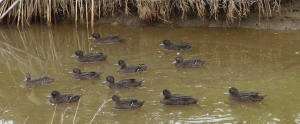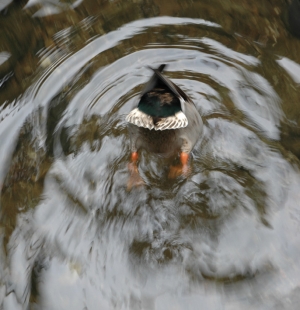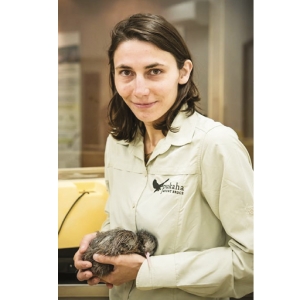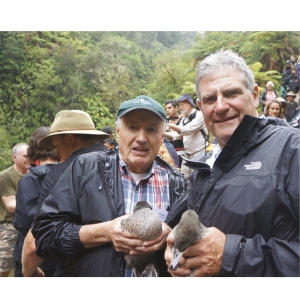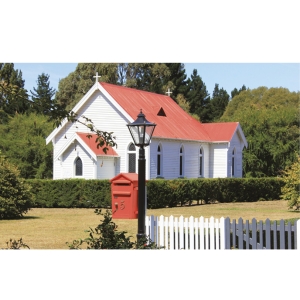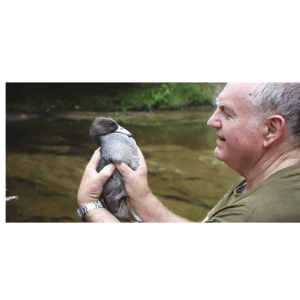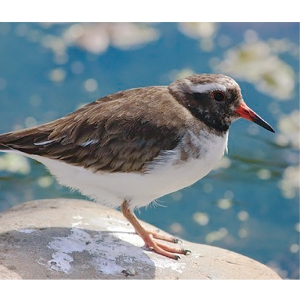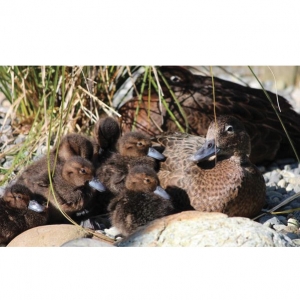Displaying items by tag: Breeding
Duck broods under constant threat from predators
Southland has long been recognised for its duck population and the associated buzz around the district during the first weekend in May!
However, the combination of several poor mallard breeding seasons in a row and in response to hunters concerns about the struggling North Island population, the Southland Fish and Game Council funded a national mallard research project. I was fortunate to have my Master’s research funded as part of this wider project.
The Southland Council had expressed concern about continual dairy conversions and the associated changes in pasture management that might affect duckling survival. Consequently, for my research I focused on female habitat selection and factors that may impact duckling survival.
In terms of pasture management, I found that duckling survival is comparable between dairy and sheep/deer pastoral grazing systems. This is good news for mallards in Southland, as we readily see our landscape convert to dairying systems. However, first and foremost, broodrearing females in Southland are selecting for ‘unmanaged habitat’ i.e., everything that is not pasture (hedgerows, shelterbelts, rank grass). This may not seem like an unexpected result, but alarmingly, these types of habitat are associated with lower duckling survival.
In our landscape, these habitats are typically thin and linear in configuration, creating ideal travelling corridors for predators. While broods may feel safe and protected tucked up in a hedgerow, predators that rely on their olfactory sensory system to track prey can easily run along the downwind side of these strips and pick up the scent of a sitting duck.
Additionally, I found that duckling survival is reduced for broods that spend their time closer to houses and roads, with both being structures that tend to be associated with a higher predator presence. Over the two year study period, 15-25 percent of our breeding females were killed on the nest by predators. To put this figure in context, this is similar to the proportion that we, as hunters, shoot each year. Further, an additional 30 percent of nests last season were abandoned or destroyed due to predators. At necropsy (post mortem examination), many of these females had evidence suggesting both mustelids and cats were the main perpetrators. While more research is needed, these results suggest that predators are having a much bigger impact on our mallard population than we originally suspected. Luckily, predator abundance is a factor that we can all influence. Further, in reducing the predator guild, you may be surprised in what other wildlife you attract!
Operation duck pond
After chasing ducks through the 2014 breeding season, staff noticed definite differences in ponds that were used by ducks and broods. Consequently, over the 2015 breeding season, we deployed 21 game cameras on ponds throughout the region that captured images every five minutes during daylight hours. If you do the math, that means I have roughly 250,000+ photos to wade through! As a result, I have not quite made it through all these photos to run the analysis. However, I can make a few comments on factors that seem to have an impact on the ponds I have made it through thus far.
Typically, the shallower ponds with plenty of feeding bottom (at least 43cm deep) have had hundreds of headless, ‘bums-up’ photos. Another example is a pond that only has water in it during the breeding season. These seasonal bodies of water tend to be the most productive in terms of invertebrate presence, and this may flow through into brood use. In last year’s study, I found that the presence of ephemeral water (short-lived bodies of water) during the first 10 days of a ducklings life, had a huge impact on survival. For Southland, cumulative duckling survival to 30 days of age without ephemeral (lasting only a short time), water present was only 11 percent for broods raised by yearling females compared to 26 percent for broods raised by adult females. However, with the presence of ephemeral water, duckling survival dramatically increased to 28 percent for broods raised by yearling females and 46 percent for broods raised by adult females. Initially, ducklings require a high protein food source, which is readily available in ephemeral water, particularly in the form of earthworms that are forced to the surface. Hence, this may be why Southland is recognised as a duck factory, and as duck enthusiasts, we shouldn’t be complaining about the weather! Consequently, management of pond water levels to mimic a seasonal body of water might be one way to encourage duck use of ponds.
Another observation that might be important to brood use is the degree of exposure of the pond to the elements. The more barren-like ponds lacking any edge, bank, or overhead cover tend to have very limited use by any mallards, and none by broods. It will be interesting to see what factors come out of the data, but my gut feeling is pond use by broods is a combination of factors that create a sheltered, food-laden haven…. Watch this space! After chasing ducks through the 2014 breeding season, staff noticed definite differences in ponds that were used by ducks
Erin Garrick
Pateke counts
A little old but of interest to those who care about Pateke.
We will obviously have to extend our daytime surveys further up into the forest in future.
I have seen Pateke way up on the open hills in pitch darkness probably 1km from their daytime roosts showing just how nocturnal they are. And Surprise, surprise WAY up stream on ecology track.
Roger and Patte Williams
Tawharanui Pateke Counts from Sharon Kast is a good record to have. This is consistent with the work of Katie Sheridan at Zealandia, her presentation to Sanctuaries of NZ hui last was of interest. Unfortunately no notes with her slides but I do remember the story was these birds go well up some of the waterways (consistent with sub fossil records that had pateke as one of our more common riverine forest bird species before mammalian depredation).
Also- ‘flock counts’ under represented the population by as much as 50 percent (proportion of known birds present at flock site at any one time, most go there eventually) and some birds with stable territories never left their home territory to visit flock sites.
Matt Maitland
For those interested in Pateke, here is a link to some interesting information and photos.
Mallards in focus – and still under threat
There is an erratum that is worth mentioning – in regards to the shallow ponds being most used by broods. The shallow ponds are all less than 43cm deep. This is the depth that is recognised in literature as the maximum depth adult mallards can reach when tipping up to feed (Phillips 1923 & Olney 1960 in Perret 1962).
Additionally, staff have now completed sifting through the 250,000+ photos from our ‘Operation Duck Pond’ study. As anticipated, ponds in Southland that were used most often by broods had the following attributes:
- A greater area of shallow feeding zone, defined as pond depth being less than 43cm (the accepted maximum depth an adult duck will feed on the bottom). The majority of the top producing ponds were in fact, 100 percent shallow feeding zone. This resulted in many photos of feeding ducks, “heads down, bums up!”
- A higher availability of food items present (such as macroinvertebrates: waterboatmen, freshwater snails, etc). Obviously, there are many factors that affect the presence and abundance of these food items in a pond.
- A suitable level of shelter particularly from the south and west pond edges, and overhead cover present along the western edge.
- A fence to keep stock off the pond periphery so that vegetated edges were not grazed by livestock. Whether this is a relationship with stock disturbance, or degree of vegetation, we do not know.
- Creating shallow (or seasonal) ponds and wetlands that are protected from the elements will be a broods favourite retreat. These factors, coupled with successful predator control should see more ducklings (and mothers) survive the breeding season. However, that leads us to our next study.
This upcoming mallard breeding season the game cameras will be placed throughout the landscape aiming to capture images of mallard nest predators, namely stoats, ferrets and feral cats. This will be combined with a heavy trapping regime and monitoring of nests within a marked study area. We look forward to reporting on our results!
Perret, N.G. 1962. The spring and summer foods of the common mallard (Anas platyrhynchos platyrhynchos L.) in south central Manitoba. Unpubl. MSc Thesis, University of British Columbia, Vancouver.
And -Yeh – looks like the same cat, obviously included the pond in its circuit – have a dozen photos where you can just see the ears and head in the grass, where it obviously just sat and watched for ages! (Camera was set on time lapse, taking photos every 5 minutes).
Erin Garrick
MB100 – a milestone for Pukaha
MB100 – a milestone for Pukaha
Pukaha was delighted to announce the 100th kiwi chick to be hatched in the nursery since it started hatching kiwi chicks under human care in September 2005 MB100 made its way into the world on March 18, 2017. Lead kiwi ranger, Jess Flamy, was on hand to assist. Jess has supervised the hatch of nine kiwi at Pukaha this year so MB100 was in very safe hands!
To celebrate the 100 milestone hatch, Pukaha held a Kids Go Free day in March when MB100 was having one of its first feeds at 12 noon.
Pateke – clutch No. 3
More conservation breeding success with the hatch of five more pateke ducklings in the Free Flight Aviary. This is the third clutch for the same pateke pair this year so they must be pretty happy in their new home. Mum is fairly happy showing off her new brood and at 4pm daily there is a ranger talk in the Free Flight Aviary and the pateke are usually happy to eat the mealworm treats they get at that time on their pond.
DOC does its bit
Kea set free after successful leg surgery
A young kea has been released back into the wild in Fiordland after his severely injured leg was successfully remodelled by vets. Thanks to Real Journeys, Air New Zealand and Meridian Energy for being involved in this happy ending.
Rare native buttercup found on Stewart Island
The mount Allen buttercup was found by DOC botanists on a remote mountain range on Stewart Island/Rakiura. The island is a hotspot for endemic plants with at least 28 native plants, many of them alpine species, found there.
Motley Crew arrive in Hawke’s Bay
Kōrure (mottled petrels) have been translocated from Whenua Hou (Codfish Island) to their new home at Maungaharuru. These translocations gave 67 birds a new home and are part of an effort to restore seabird populations.
Restoring the balance for whio
Horizons Regional Councillors joined DOC representatives and iwi at Blue Duck Station in February 2017 for a whio release, during a tour of the northern parts of the ManawatuWhanganui Region. Blue Duck Station set within the Kia Wharite project, has seen Horizons, DOC, Whanganui iwi and
private landowners working in the private lands and remote forests around Whanganui National Park to improve land, water and biodiversity, while enhancing community and economic wellbeing. Kia Wharite is one of the largest projects of its kind in New Zealand in scale and scope.
Back in February, way before the weather bomb hit Blue Duck Station, (see page 7) Horizons Regional Councillors joined the Department of Conservation (DOC) deputy director general operations, Mike Slater, and iwi representatives for the release of 14 whio at Blue Duck Station.
The whio release was a hands-on opportunity to show how Kia Wharite, a collaborative biodiversity project in the Whanganui/ Ruapehu districts, is directly contributing to the survival of native species.
Since 2008, Horizons, DOC, Whanganui iwi and private landowners have been working in the private lands and remote forests around Whanganui National Park to improve land, water and biodiversity health, while enhancing community and economic wellbeing. Kia Wharite is one of the largest projects of its kind in New Zealand in terms of scale and scope.
The Kia Wharite project spans over 180,000 hectares and includes a mixture of private land and parts of the Whanganui National Park, the second largest lowland forest in the North Island. This remote area is home to the largest population of Western North Island brown kiwi and plays host to many native bird and plant species.
Possums, goats, stoats and other predators have threatened the health of the forest and put the long-term future of its inhabitants in jeopardy.
Horizons Councillor Bruce Rollinson said as part of the project extensive possum control operations have been undertaken by Horizons and OSPRI on rated land, and DOC on crown land. OSPRI have signalled a phased withdrawal from areas inside the project sites, as these areas are declared TB free. Currently approximately 150,000 hectares of land has regular possum control undertaken in the project area.
This work, alongside pest and weed control, protecting bush and wetlands and monitoring threatened native species, is also why it was possible to release 14 whio into the Kaiwhakauka Stream. Here, whio are protected on the river through a network of traps managed by Blue Duck Station volunteers to target stoats, said Cr Rollinson.
Predator control is carried out in the wider whio security site by Horizons and DOC; over 85 km of trap lines are in place along the Retaruke and Manganui o te Ao rivers, providing necessary protection for whio.
Department of Conservation deputy director general operations Mike Slater said with a population of fewer than 3000, this national whio security site is one of eight locations identified across the country as being essential for whio recovery.
With the support of Genesis Energy, DOC has been able to double the number of fully secure whio breeding sites, boost pest control efforts and enhance productivity and survival of these rare native ducks. The ultimate goal of this security site is to achieve protection to 50 breeding pairs, said Mr Slater.
Whio are adapted to live on fast-flowing rivers so finding them means you have also found clean, fast-flowing water with a good supply of insects. This makes whio important indicators of ecosystem health, they only exist where there is high quality, clean and healthy waterways.
It is not just whio and the environment that benefit from the project. Horizons and DOC believe there are positive economic returns to be had from the project. Blue Duck Station is the most obvious example.
The sheep and beef cattle farm, located 55km south-west of Taumarunui, is set on 2915 hectares of medium to steep hill countryDuck Station owner and manager Dan Steele said grazing areas have been deliberately offset by native bush and manuka. “Through the Kia Wharite project, we have
worked closely with Horizons and DOC to develop a sustainable land plan, and fence ofselected farm areas to protect native fauna and flora,” said Dan Steele.
“The Station has approximately 450 traps for stoats, mustelids, feral cats, rats, mice and hedgehogs; all enemies of the blue duck as well as other native species. In partnership with Kia Wharite, we maintain and reset the traps approximately every two weeks; this is undertaken mainly by our olunteers or ecowarriors as we call them.
“Embracing the environment in this way provided the perfect place to set up a lodge and tourism operation. In a relatively short time we have grown to approximately 8000 visitors a year, many of whom become ecowarriors during their stay,” said Dan Steele.
Cr Rollinson said Kia Wharite is proving to be a successful approach, with the project already exceeding some of its goals. “It shows what can be accomplished when organisations join forces and work collaboratively.”
Isaac Conservation Trust
The Isaac Conservation and
Wildlife Trust
The Isaac Conservation and Wildlife Trust, established in 1977 continues the land rehabilitation and conservation work of Sir Neil and Lady Diana Isaac.
The Trust is self-funding and does not solicit for monies. It is the assets, bequeathed to the Trust from Sir Neil and Lady Isaac that provide the income to continue their philanthropic contribution to conservation.
The main focuses are the conservation of endangered native flora and fauna, the conservation of heritage buildings and the study of conservation through education and research. This study of conservation and the environment is embodied by funding two post graduate scholarships annually, at both Canterbury and Lincoln Universities.
Specialised captive breeding of New Zealand native birds, reptiles and fish, with the aim of reintroduction into the wild, is carried out to stabilise and reverse declines in at-risk species. The Trust currently holds New Zealand shore plover, orange-fronted parakeet, red-crowned parakeet, black stilt,
blue duck, brown teal, Cook Strait tuatara, grand skink, Otago skink and Canterbury mudfish.
The Trust also breeds Cape Barren geese and mute swan, which are donated to Ducks Unlimited New Zealand.
The Trust has decades of animal husbandry and captive breeding experience, specialising in New Zealand species on the brink of a high threat status. This area of the Isaac Conservation Park is off limits to the public due to the fragility of its inhabitants.
Lady Isaac was not just a wildlife conservationist, but also a conservationist of historic buildings. The development of the Isaac Heritage Village is comprised of 14 relocated historic Canterbury buildings.
Many of these unique and irreplaceable buildings (c.1860 to 1940), were threatened with demolition. The Heritage Village will eventually be open to the public. Revegetation of plants on the Isaac Conservation Park land includes a focus on the restoration of the Otukaikino River, feeding into the Waimakariri River. To date the Trust has fenced off waterways from stock, extensively cleared weeds, and planted over 45,000 eco-sourced natives. Along the corridor of native plants that now line the river, land has been set aside to provide a public walkway.
The Trust has been set up to exist in perpetuity to provide a benchmark in conservation, continuing the legacy of Sir Neil and Lady Isaac.
Catherine Ott
Fears for Whio
Fears for whio after weather bomb
February (2017) brought a highlight on the conservation calendar at Blue Duck Station – the release of 14 rare juvenile blue ducks (whio) into the Kaiwhakauka Stream.
After months of preparation in which the young whio were raised in captivity and prepared for life in the wild on an artificial stream, teams from Blue Duck Station, the Department of Conservation (DoC), Horizons, and Whio Forever saw the ducks off into their new home as part of a community event at Blue Duck Falls. A representative from the local iwi blessed the ducks before volunteers released them into the Kaiwhakauka, watching as they swam upstream into their new habitat. The long term aim is for the ducks to form breeding pairs along the length of the Kaiwhakauka stream, further strengthening the local whio population.
Unfortunately, the joy was short lived. In March a weather bomb wreaked havoc along the Kaiwhakauka. Over 100ml of rain fell in one day, causing flash floods and land slips that battered the Station. The environment around the Kaiwhakauka changed drastically – fallen trees and boulders littered the river, while flooding risked washing away the newly released whio. High water levels also threatened the whio’s ability to feed in the stream and with the stream bed turned upside down, it is unclear how much feed is left for the ducks.
While the damage is severe, the team at Blue Duck Station remain optimistic. In the coming months they will be assessing the impact and planning how best to help the ecosystem recover. Sightings of juveniles have continued in the surrounding areas since the floods, so hopes are high that habitats can be restored for further releases in the future and that Blue Duck Station will continue to be a haven for whio.
Maxine Ross, David Atkinson.
Shore Plover breeding success at Pukaha Mount Bruce
The mission to save more than one endangered bird species has been enriched by last year’s successful breeding programmes at Pukaha Mount Bruce.
The Shore Plover programme saw over 10 birds transported from Pukaha Mt Bruce National Wildlife Centre to Motutapu Island in the Hauraki Gulf and Portland Island off the Mahia peninsula.
The shore plover is in a perilous position with fewer than 200 left in the wild and a history of conservation efforts being hampered by rat infestations. Shore plover were first spotted by observers on Captain Cook’s second voyage to New Zealand.
The shore plover is the most endangered bird reared and cared for at the centre. It is very susceptible to mammalian predators, even one rat can cause enormous damage.
Past Department of Conservation attempts to establish shore plover on Mana and Portland Islands were undone by what was thought to be a single rat in both cases.
The breeding and hatching of over 10 chicks at Pukaha had been a real triumph for the staff and wider conservation efforts.
In another success for the breeding programme, there were also over 10 pateke (brown teal) bred and hatched at the centre in the last breeding season.
The endangered ducks have a wild population of between 2,000 and 2,500 making them New Zealand’s most rare mainland waterfowl.
As well as great results in the Shore Plover and Pateke recovery programmes, the Whio (Blueduck) also produced more than one clutch of ducklings.
Pukaha’s new free flight aviary that opened in May 2016 enabled the breeding pair of Whio that call it home, to lay eggs which were then artificially incubated and hand-reared. Those ducks were sent to Turangi where they spent time in a purpose-built environment to prepare them for release to the wild.
The second clutch of eggs is allowed to stay with the parents and be raised naturally.
The theory is that by letting the parents raise them, the ducklings will be better parents when it is their time to breed.
By Illy McLean and Laura Hutchinson
New hatchings at Pukaha Mount Bruce
September 2017: Pukaha Mt Bruce
Since staff at Pukaha last caught up, the Pateke pair now have six ducklings in their care. The Whio, that live in their free flight aviary have also been sitting on a clutch of five eggs.
Also the first monitored wild kiwi chicks were safely hatched in the reserve. Staff said it was great to see the first conservation breeding of the season had taken place in the new free flight aviary. It is a super sign that the wildlife love this new space as much as the visitors who go to see the new young ones at Pukaha.
Free flight aviary popular at Pukaha Mt Bruce
At Pukaha Mt Bruce staff have been delighted with the way the birds have settled into their new home in the free flight aviary. The whio and pateke are loving their new areas and are not difficult
to spot. The whio are in an ‘internal aviary’ with a new river run while the other birds are all together in the bigger aviary space. Both the pateke and whio are breeding pairs.
The korimako seem to spend all day singing and while the kaka and kereru took a little while to settle in, they are now happy and busy in their new space and are almost oblivious to the visitors
who walk through the aviary.
If you are lucky enough to be at Pukaha at the free flight aviary at around 4pm there could be a ranger talk at the “Final Flight” area. It tells the story of the restoration project for the Pukaha forest and how captive breeding can help to protect and grow our endangered species.

